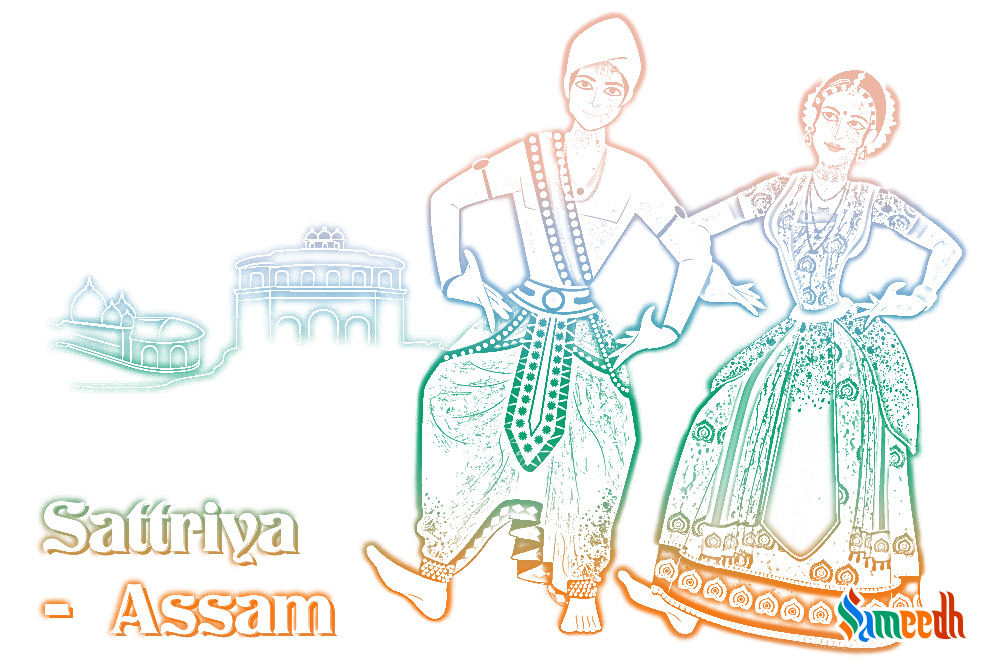The Sattriya Nritya is the traditional dance form of Assam, where the dancers use hand and facial expressions to portray historical and religious stories of the epics like the Mahabharat and Ramayan.

Sattriya is a well-known Indian classical form from the Indian subcontinent’s north eastern regions. It was originally performed in the Hindu monasteries by the monks in the form of a dance play, based on the stories of Bhagwan Krishna.
Origination of Sattriya Nritya
The Sattriya Nritya is the traditional dance form of Assam, a state in north-eastern India. The plays are largely dedicated to the life of Bhagwan Krishna and Radha ji or their former avatars Bhagwan Ram and Maa Sita, and the dance form is essentially a devotion to the Vaishnav school of Hinduism.
Dance has a long history in Assam, as indicated by copper plate inscriptions and artwork related to the Shiv and Shakti traditions. Similarly, the Assamese chorus singing tradition for the Hindu epics the Ramayan and the Mahabharat may be traced back to Assamese musical and singing traditions. Sankardev, who systematised the dance using ancient literature and included drama and expressive dancing as a kind of community religious art for emotional devotion to Krishna, is credited with the present form of Sattriya.
Monks developed and practised the art in Hindu monasteries in the form of dance based on the stories of Bhagwan Krishna, particularly from scriptures like the Bhagavat Puran. One feature of the Sattriya dance performed within temples and monasteries is that it is done in front of a copy of the Bhagavat Puran called Manikut of the dance hall, which is located in the eastern corner.
Based on the Natya Shastra, by Bharat Muni
Sattriya Nritya is a type of dance play that uses hand and face expressions to portray historical and religious stories. A Sattriya’s basic dance unit is called a Mati Akhara, which, like Natya Shastra, equals 64. These are the foundational sets dancers learn during their training. Ora, Saata, Jhalak, Sitika, Pak, Jap, Lon, and Khar are the subgroups of the Akharas. A performance combines two styles: masculine (Paurashik Bhangi) and feminine (Stri Bhangi).
Dance rituals and costumes
Sattriya was traditionally performed in monasteries only by Keuliyabhokots (male unmarried monks) as part of their daily routines or to commemorate special occasions. Sattriya is now performed on stage by men and women who are not members of the sattras. The male costume, which consists of the dhoti and chadar as well as the paguri (turban), and the female costume, which consists of the ghuri, chadar, and kanchi, are the two main types of Sattriya dance costumes. The outfits were traditionally white or raw silk, with red, blue, and yellow used for special dance pieces.
Conventional musical instruments
The khol (two-faced, asymmetrical drum) played with fingers is a major musical instrument that accompanies a Sattriya performance. Sattriya khol’s unique design and materials, which include building clay, wood, leather, rice dough, iron filings, and rope straps, produce a high pitch on the right side and a deep bass sound on the left. The flute and several varieties of Taals (Manjira, Bhortal, Bihutal, Patital, Khutital) accompany the khol. Other instruments, such as the violin and harmonium, have only recently been added.
Decorative Jewelleries
Sattriya dance uses traditional Assamese jewellery, created in raw gold. Performers wear Kopali on their foreheads, Muthi Kharu and Gam Kharu (bracelets), and a variety of neck pieces such as Mata Moni (for male dancers), Golpata, Dhulbiri, Bena (pendant shaped like a crescent), Jethipata, Dugdugi, Senpata, Dhansi. Dancers also wear earrings and Thuka Suna and Keru, which have similar patterns. White flowers adorn the hair of female dancers.